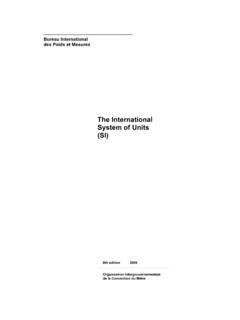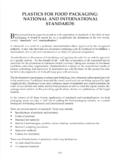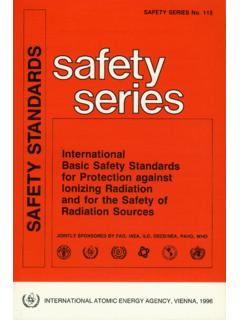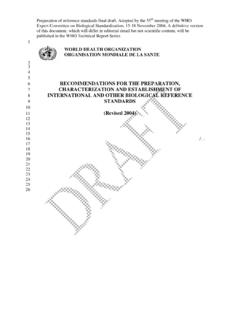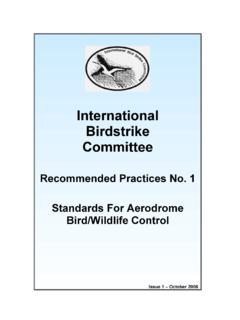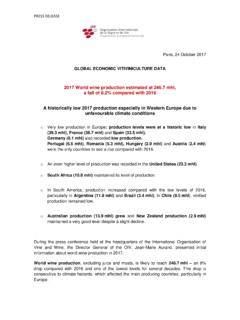Transcription of Benchmarks for training - World Health Organization
1 Benchmarks for training in traditional / complementary and alternative medicine Benchmarks for training in Osteopathy WHO Library Cataloguing-in-Publication Data Benchmarks for training in traditional /complementary and alternative medicine: Benchmarks for training in osteopathy. medicine. therapies. Health Organization . ISBN 978 92 4 159966 5 (NLM classification: WB 940) World Health Organization 2010 All rights reserved. Publications of the World Health Organization can be obtained from WHO Press, World Health Organization , 20 Avenue Appia, 1211 Geneva 27, Switzerland (tel.)
2 : +41 22 791 3264; fax: +41 22 791 4857; e-mail: Requests for permission to reproduce or translate WHO publications whether for sale or for noncommercial distribution should be addressed to WHO Press, at the above address (fax: +41 22 791 4806; e-mail: The designations employed and the presentation of the material in this publication do not imply the expression of any opinion whatsoever on the part of the World Health Organization concerning the legal status of any country, territory, city or area or of its authorities, or concerning the delimitation of its frontiers or boundaries.)
3 Dotted lines on maps represent approximate border lines for which there may not yet be full agreement. The mention of specific companies or of certain manufacturers products does not imply that they are endorsed or recommended by the World Health Organization in preference to others of a similar nature that are not mentioned. Errors and omissions excepted, the names of proprietary products are distinguished by initial capital letters. All reasonable precautions have been taken by the World Health Organization to verify the information contained in this publication.
4 However, the published material is being distributed without warranty of any kind, either expressed or implied. The responsibility for the interpretation and use of the material lies with the reader. In no event shall the World Health Organization be liable for damages arising from its use. Printed in Switzerland. Contents iii Contents Contents .. iii Acknowledgements .. v Foreword .. vii Preface .. ix Introduction .. 1 1. The basic principles of osteopathy .. 3 Philosophy and characteristics of 3 Structure-function relationship models.
5 4 2. training of osteopathic practitioners .. 7 Categories of training 7 Core competencies .. 8 benchmark training curriculum for osteopathy .. 8 Adaptation of Type I to Type II programmes .. 10 3. Safety issues .. 15 Contraindications to direct techniques .. 15 Contraindications to indirect, fluid, balancing and reflex-based techniques .. 16 19 Annex: WHO Consultation on Osteopathy, Milan, Italy, 26 28 February 2007: list of participants .. 21 Benchmarks for training in osteopathy iv Acknowledgements v Acknowledgements The World Health Organization (WHO) greatly appreciates the financial and technical support provided by the Regional Government of Lombardy, Italy, for the development and publication of the basic training documents, as part of the implementation of collaborative projects with WHO in the field of traditional medicine.
6 The Regional Government of Lombardy kindly hosted and provided financial support for the WHO Consultation on Osteopathy, held in Milan, Italy in February 2007. WHO also wishes to express its sincere appreciation to Dr Jane Carreiro, College of Osteopathic Medicine, University of New England, Maine, United States of America, for the preparation of the original text. WHO acknowledges its indebtedness to over 200 reviewers, including experts and national authorities as well as professional and nongovernmental organizations, in 57 countries who provided comments and advice on the draft text.
7 Special thanks are due to the participants of the WHO Consultation on Osteopathy (see Annex) who worked towards reviewing and finalizing the draft text, and to the WHO Collaborating Centre for Traditional Medicine at the State University of Milan, Italy, in particular to Professor Umberto Solimene, Director, and Professor Emilio Minelli, Deputy Director, for their support to WHO in organizing the Consultation. Benchmarks for training in osteopathy vi Foreword vii Foreword The oldest existing therapeutic systems used by humanity for Health and well- being are called Traditional Medicine or Complementary and Alternative Medicine (TM/CAM).
8 Increasingly, TM/CAM is being formally used within existing Health -care systems. When practised correctly, TM/CAM can help protect and improve citizens Health and well-being. The appropriate use of TM/CAM therapies and products, however, requires consideration of issues of safety, efficacy and quality. This is the basis of consumer protection and is no different, in principle, from what underpins modern medical practice. Upholding basic requirements for the modern practice of TM/CAM therapies can support national Health authorities in the establishment of adequate laws, rules, and licensing practices.
9 These considerations have guided the work of the Regional Government of Lombardy in TM/CAM which was first included in the Regional Health Plan 2002-2004. Clinical and observational studies in the region of Lombardy have provided a crucial step in the evaluation of TM/CAM. With the help of data from these studies, a series of governmental provisions have been used to create a framework for the protection of consumers and providers. The cornerstone of this process was the first Memorandum of Understanding (MOU) for the Quadrennial Cooperation Plan which was signed between the Regional Government of Lombardy and the World Health Organization .
10 The MOU highlighted the need for certain criteria to be met including: the rational use of TM/CAM by consumers; good practice; quality; safety; and the promotion of clinical and observational studies of TM/CAM. When they were published in 2004, the WHO guidelines for developing consumer information on proper use of traditional, complementary, and alternative medicine were incorporated into this first MOU. In the region of Lombardy, citizens currently play an active role in their Health -care choices.











